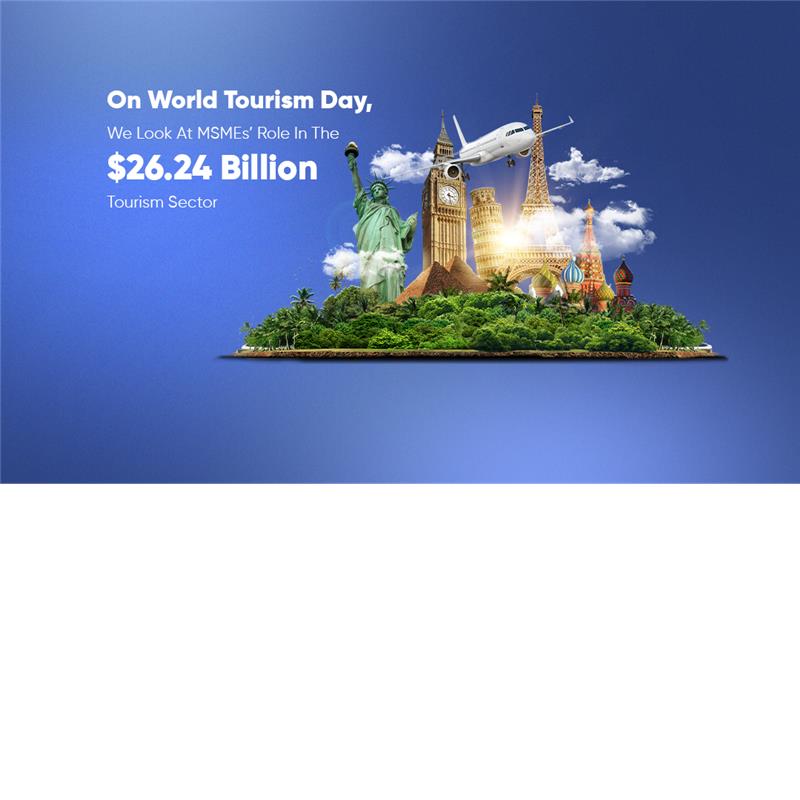On World Tourism Day, We Look At MSMEs’ Role in the $26.24 billion Tourism Sector
- MSMEs form the backbone of India’s tourism, powering growth across cities, towns, and rural landscapes.
- They contribute significantly to hospitality, travel services, handicrafts, and tourism-support infrastructure like rentals and digital booking systems.
- Despite their role, MSMEs face challenges such as limited access to credit, weak digital visibility, and competition from larger players.
- Government schemes and financial support from RBI-registered NBFCs like Protium can help them upgrade, scale, and integrate into the digital tourism ecosystem.
The travel and tourism market in India is estimated to generate US $26.24 billion in revenue in 2025, and with a projected CAGR of 15.67% between 2025 and 2030, it is expected to reach a market size of US $54.34 billion by 20301 and US $3 trillion by 20472. While these numbers highlight growth potential, it is important to recognize that the real drivers of India’s tourism experience are not limited to luxury hotels or large travel operators. Instead, MSMEs form the backbone of the tourism ecosystem. They run local hotels, operate taxis, manage tour packages, craft souvenirs, and even build digital booking systems.

On World Tourism Day 2025, 27 September, we look at how MSMEs play a defining role in tourism, powering hospitality and accommodation, travel services and transport, arts and handicrafts, and supporting infrastructure such as logistics, rentals, and digital platforms.
Hospitality and Accommodation
Small-sized hotels, guesthouses, boutique stays, and homestays form the backbone of India’s accommodation network, especially in Tier-2 and Tier-3 destinations. However, only 1,728 hotels were classified under the government’s star-rating system in 20223, which highlights the limited presence of branded properties when compared to the vast demand from domestic and foreign travelers.
Challenges & Support
Despite their importance, small hoteliers face persistent challenges. Many find it difficult to access affordable finance for renovations and infrastructure upgrades. Lack of visibility on online booking platforms reduces their ability to attract international tourists. At times, inconsistent service quality creates a trust deficit, making travelers prefer larger chains.
The govt aims to develop tourism circuits and enhance infrastructure with the Swadesh Darshan Scheme, which will build tourism infrastructure and promote sustainable, responsible destinations across India. While its first phase emphasized theme-based tourist circuits, the program has now been restructured as Swadesh Darshan 2.0, which takes a destination-centric approach aligned with the vision of Aatmanirbhar Bharat (Self-Reliant India). Under this framework, the Ministry of Tourism provides financial assistance to State and Union Territory governments, as well as central agencies, for approved projects.
As destinations under the scheme receive better infrastructure, connectivity, and promotional visibility, local enterprises can benefit from increased visitor flow. By forming clusters of small hotels, homestays, tour operators, and craft sellers, MSMEs can collectively market themselves as part of these recognized circuits. Clusters also enable them to adopt shared quality benchmarks, design integrated tourism packages, and negotiate better access to credit and training programs. MSMEs in hospitality can thereby improve competitiveness while maintaining their local character.
Travel Services
Tourism cannot function without reliable transport, itinerary planning, and last-mile connectivity. Travel services and transport in India covers domestic operators, inbound agencies, adventure operators, and guides. A significant share of these are MSMEs, particularly in smaller towns and regions that attract pilgrims, heritage seekers, or nature enthusiasts.
This is how they contribute:
- Affordable and customized services – Small operators design itineraries tailored to local demand, from heritage walks to eco-tours.
- Last-mile connectivity – Local taxi services, minibuses, and jeeps fill transport gaps in hilly and rural tourist destinations.
- Digital adoption – MSMEs increasingly accept UPI and online bookings, making travel smoother for domestic and international tourists.
- Community engagement – Many MSMEs integrate local communities into their operations, ensuring that tourism revenues flow to village households and artisans.
Challenges & Support
Small operators often struggle with regulatory compliance, as licensing, permits, and taxation requirements can be complex. Limited budgets further restrict their ability to advertise or build visibility in international markets. The lack of robust booking platforms and inventory systems places them at a disadvantage against larger competitors. In response, the National Digital Tourism Mission has been launched to build a unified digital ecosystem, enabling small travel firms to integrate their services with larger platforms and expand their reach. By leveraging such initiatives, MSMEs in travel and transport can scale their businesses while preserving their personalized service models.
Arts, Handicrafts, and Souvenirs
Tourism in India is incomplete without its crafts and cultural expressions. The handicraft sector supports nearly 7 million artisans, many of whom operate as small businesses in villages and towns4. For tourists, these enterprises offer souvenirs, handmade goods, and cultural experiences that represent the essence of a region. Craft clusters and artisan villages often become destinations in their own right, attracting visitors who seek authentic engagement.
The impact of MSMEs in this segment extends to global markets as well. Handicraft exports touched US $4 billion in FY 2023–24, underscoring the commercial potential of Indian crafts on the international stage5. For travelers, purchasing local handicrafts or attending artisan workshops creates both a memory and a livelihood linkage for the community. Rural participation is especially important here, as artisans based in small towns and villages can connect with a steady flow of tourism income.
MSMEs further contribute to the industry by:
- Preserving traditions – Small craft units maintain age-old practices in textiles, pottery, woodwork, and jewellery.
- Souvenir and retail – Tourists purchase locally made goods, turning culture into livelihood for artisans.
- Experiential tourism – Workshops and live craft demonstrations run by MSMEs add interactive value for visitors.
- Rural participation – Crafts often originate from rural communities, allowing tourism to extend beyond cities.
Challenges & Support
Artisan enterprises face hurdles in standardizing quality and creating tourist-ready packaging, which often reduces competitiveness. They also encounter pricing pressure from machine-made souvenirs and imported goods. Limited access to larger markets further restricts their growth potential. Government-backed programs that provide design training, cluster development, and Geographical Indication (GI) tagging are essential to safeguarding these traditional crafts. When tourism circuits incorporate craft villages into itineraries, artisans gain direct exposure to customers, ensuring that handicrafts remain both a cultural and economic strength.
MSMEs in Logistics, Equipment Rentals, and Digital Solutions
Beyond hotels, tours, and souvenirs, tourism requires a strong supporting ecosystem. MSMEs provide much of this through logistics, vehicle rentals, equipment leasing, maintenance, and digital booking systems. From bicycle rentals in heritage towns to trekking gear in adventure destinations, small enterprises fill gaps that large firms often overlook.
Digital adoption has become a particularly important area of contribution. India’s e-Tourist Visa facility was used by over 3.4 million foreign nationals in 20236, showing how critical digital systems are to tourism flows. While government platforms provide entry and facilitation, MSMEs build the smaller digital applications that support hotels, tours, and local attractions. Affordable booking engines, property management tools, and mobile apps developed by small IT firms enable other MSMEs in the sector to reach customers more effectively.
Contributions of MSMEs in the segment include:
- Bridging infrastructure gaps – MSMEs operate in remote areas where large service providers are absent.
- Affordable services – Flexible rental and support solutions are tailored to specific destination needs.
- Innovation in booking – Small IT firms create cost-effective booking tools for local hotels and tour operators.
Challenges & Support
The primary challenges in this segment are financial and technical. High upfront costs for equipment and the skills required for secure digital development pose barriers to entry. Maintenance-focused MSMEs also find it difficult to expand capacity or invest in advanced systems. On the support side, the National Digital Tourism Mission provides a shared digital backbone, which can lower entry barriers for small tech-driven firms. Complementary skilling initiatives in cybersecurity, app design, and digital marketing can further enhance their capacity to thrive in the tourism value chain.
India’s tourism sector is expected to expand rapidly over the next decade, but its ability to generate inclusive growth rests largely on the shoulders of MSMEs. From operating accommodations and tours to preserving crafts and supporting infrastructure, these enterprises ensure that tourism is authentic, employment-intensive, and rooted in local communities.
For policymakers and financial institutions, the path forward must include easing access to credit, expanding skilling opportunities, and ensuring that MSMEs are fully integrated into digital transformation programs. Financial support from RBI-registered NBFCs such as Protium can also play a pivotal role by offering tailored loan solutions that help MSMEs upgrade facilities, invest in technology, and expand operations. By nurturing the enterprises that shape everyday tourism experiences, India can not only meet its ambitious revenue targets but also ensure that the sector remains inclusive, sustainable, and culturally enriching.

